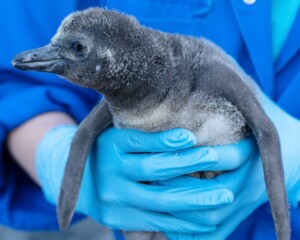Ocean Park Conservation Foundation, Hong Kong (OPCFHK) proudly announced China’s first successful artificial restoration of a seabird species.
With years of funding support from OPCFHK, the Hong Kong Bird Watching Society and BirdLife International, together with local and foreign experts, have successfully attracted the critically endangered Chinese crested terns to breed on Jiushan Islands National Nature Reserve in Zhejiang Province.
The restoration team started clearing the vegetation and rodents at the selected project site in May. Due to the social behavior of the terns, the team then installed 300 tern decoys and solar powered playback systems to attract great crested terns and Chinese crested terns. After several months of efforts, about 19 Chinese crested terns and 2, 600 great crested terns were attracted to the island for breeding. By the end of September, researchers recorded at least one Chinese crested tern chick and a total of 600 great crested terns had successfully fledged.

With an estimated population of not more than 30 individuals, Chinese crested tern is now listed as "critically endangered" in the International Union for Conservation of Nature (IUCN) Red List of Threatened Species, making it one of the most threatened bird species in the world, even rarer than giant pandas in China. This “Legendary Bird” was believed extinct before their reappearance at Matsu Islands, Taiwan in 2000; and was later discovered in Jiushan Islands in Zhejiang Province in 2004. OPCFHK has been supporting Chinese crested tern research and conservation projects conducted by Hong Kong Bird Watching Society and BirdLife International since 2008, which included local community and fishermen education to enhance their awareness in protecting seabirds; and advocacy works on preventing illegal seabird eggs collection and trafficking.

In early May 2013, the Hong Kong Bird Watching Society and BirdLife Asia Division, joined hands with experts from the Oregon State University, the Zhejiang Museum of Natural History and the Jiushan National Nature Reserve, to initiate the project on the restoration of the Chinese crested tern breeding population, using decoys and call playback techniques. If the relatively-common great crested terns would recolonise the island, their numbers would grow gradually. The Chinese crested terns, which had always been found nesting in large colonies of great crested terns, would hopefully then land on the site to nest.

"The results and achievements are encouraging, " said BirdLife International Asia Division Senior Conservation Officer, Simba Chan, "The team did not just attract terns to breed on the project site; the record of 19 Chinese crested terns has been the highest single count since 2000! This technique has been applied on other tern species in the States with a few success stories. We are confident that we can conserve other threatened bird species in the region with this technique. The team will carefully prepare for the monitoring in the upcoming breeding season, including weed and pest control, and monitoring station establishment with a resident team."
Ms Suzanne Gendron, OPCFHK’s Foundation Director, stated that “Since 2008, the Foundation has allocated over $0.25 million to support Chinese crested tern conservation projects. We are delighted to see the success of these joint conservation efforts of organizations and experts from Hong Kong, Mainland China and other countries. In 2013/14, the Foundation will continue to support the project: Monitoring of the Breeding Population and Conservation Promotion of Chinese Crested Tern against Extinction. The project is aimed at reducing the threats to Chinese crested terns and enhancing their wild population through close monitoring and community education.”
For more information: https://www.opcf.org.hk/en/fof.php, www.hkbws.org.hk and www.chinabirdnet.org.
Images: From top – Great crested terns and chicks. (Photo credit: Dan Roby)
Decoys and call playback device (Photo credit: Vivian Fu)
Chinese crested tern (front) and great crested tern (back) (Photo credit: Dan Roby)














